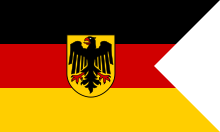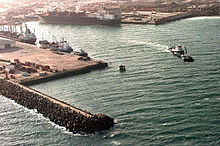Operation Southern Cross
The Operation Southern Cross (German: Southern Cross ) was a military operation of the German Navy under national command. It served to return the German Somalia Support Association of the German Army deployed as part of Operation UNOSOM II back home. The operation lasted from January 27 to April 15, 1994.
background

On the basis of Resolution 814 of the United Nations Security Council of March 26, 1993, the UN organization Unified Task Force (UNITAF) , which had already been set up in Somalia , received an order for peacekeeping and humanitarian aid in the East African state affected by civil war. This UN mission was named United Nations Operation in Somalia II (UNOSOM II).
On April 21, 1993, the Federal Cabinet decided to support the UN in Somalia by deploying a reinforced supply and transport battalion to be deployed in the city of Beledweyne in the east of the country. The relocation of the main contingent began in July 1993, the total strength was 1700 soldiers of the army. In addition to humanitarian aid for the civilian population, the German association provided support for an Italian contingent of around 500 soldiers. An Indian brigade, whose support was the intended mission of the German troops, was never relocated to Somalia.
On December 20, 1993 the German government decided to end the operation in view of the deteriorating security situation in Somalia and to withdraw the troops by March 31, 1994.
Advance to Operation Southern Cross
After the decision to withdraw, it was initially intended to move the Somalia Support Association by land to Mogadishu . From there, the material was to be transported on by merchant ship , while the personnel were to return to Germany by air. This operation should be supported by US troops and protected if necessary.
Due to the noticeably deteriorating security situation, the Navy had offered early on to send a ship formation to the sea area off Somalia to support the operation. In particular, telecommunication equipment, medical equipment and on- board helicopters should be used for this purpose . After this offer was rejected in view of the expected US aid, the ship was sent on a training trip to South America .
In January 1994 it became known that the USA would withdraw faster than expected after the defeat it suffered in the so-called Battle of Mogadishu in October 1993 and that the US armed forces would not be able to keep their aid pledges to Germany because of political guidelines. Because the USA had also decided to withdraw by sea, Defense Minister Volker Rühe decided on January 21st to move the German troops with the help of the Navy to safe havens outside Somalia, while the material was to continue to be transported by merchant ships.
Task Group 500.02
Because the training association was no longer available for this task, the establishment of a new association called Task Group 500.02 (TG 500.02) was ordered on January 24, 1994 . It consisted of the frigates Cologne ( flagship ) and Karlsruhe , the utility Nienburg and the civilian tanker Spessart and was led by the commander of the 2nd destroyer squadron , Captain Gottfried Hoch , as the Commander Task Group (CTG 500.02). In this function he was directly subordinate to the fleet command in Glücksburg.
The frigates carried a total of four SeaLynx Mk 88 helicopters . The workforce was around 550 soldiers and civil servants. None of the ships were designed to carry troops. In order to be able to accommodate the army soldiers, 200 additional beds were set up in the hold of the "Nienburg". A few empty berths and temporary accommodation in different rooms were available on the frigates. In addition, the bunks were alternately occupied by crew members and army soldiers traveling with them.
Course of the operation
Approach
Between January 28 and February 1, 1994 "Karlsruhe", "Nienburg" and "Spessart" left Wilhelmshaven and Kiel, respectively . As part of the NATO group STANAVFORMED, “Cologne” was already in the Mediterranean and monitored the embargo in the Adriatic as part of Operation Sharp Guard . The CTG and its staff embarked in Taranto on the "Cologne" located there, which ran ahead of the rest of the association and arrived in Mogadishu for the first time on February 13 to pick up a first contingent. The remaining ships needed a little longer for the approx. 6000 nautical miles long approach from Germany and reached Mogadishu for the transport of the second contingent.
Troop transport
The Somalia Support Association was moved back in six contingents, each of which marched around 330 km by land from Beledweyne to Mogadishu with their vehicles. In Mogadishu, the heavy equipment was loaded onto German merchant ships, while the soldiers in the harbor boarded warships that took them to Mombasa in Kenya . Only the last contingent was transported on the march back of the naval unit towards Germany to Djibouti .
For the first transport of 102 soldiers on February 13, only the frigate "Köln" was available, for the later also "Karlsruhe" and "Nienburg". “Spessart” did not transport any personnel, but was responsible for supplying the association with fuel. The port of Mogadishu, the security situation of which was steadily deteriorating, was called for as short as possible to receive the soldiers . It was estimated that 100 soldiers could be accommodated in 10 minutes, the total lay-in time for loading was 20 minutes, and the entire port was one hour. Snipers in the old town near the port were seen as a threat . Defense was to be carried out with light on-board guns (frigates 20 mm, Nienburg 40 mm), with the exception of the last contingent, German army forces (parts of Luftlandebrigade 26 , Gebirgsjägerbrigade 23 and Kommandokompanie 5./261 from Lebach ) with "Wiesel" secured. In addition, a wall of containers protected the berths. The subsequent journey of around 500 nm to Mombasa lasted two days each.
After the withdrawal of US and Italian forces in Mogadishu, the situation in Mogadishu worsened considerably. The airport was shelled on March 8 and had to be temporarily closed. On March 16, while German equipment was being loaded, a mortar shell struck not far from the merchant ship “Mercandian Queen”. It was therefore decided to fly out the last contingent of around 180 soldiers with on-board helicopters.
Of the 1700 or so soldiers in the support association, 1492 were transported by sea. The rest had previously been flown directly from Beledweyne by transport aircraft.
Support from the sea
In addition to transport, the navy supported the army in various ways from the sea. Communication facilities were provided to ensure the connection between the land forces and their homeland during the march. While army contingents were moving towards Mogadishu from land, SAR readiness was temporarily established. The on-board medical facilities were available in the event of wounds. In order to be able to provide this service at all times, a frigate with on-board helicopters remained in front of Mogadishu from the beginning of March until the departure of the last contingent.
March back
On March 23, 1994, the TG 500.02 left the Somali coast with the last contingent and began to march back. The army soldiers were disembarked in Djibouti and flown home from there. The ships of the TG 500.02 reached their home ports again in mid-April. The last ship to enter Kiel was the “Spessart” on April 15, 1994, while the other ships had already been welcomed the day before by the State Secretary in the Ministry of Defense, Jörg Schönbohm, in Wilhelmshaven.
Experiences, lessons and appreciation
The Somalia mission was the German army's first major foreign mission. He made clear the need to take adequate precautions in the event of a necessary withdrawal from an operation. This led to the demand for a suitable ship that could transport troops across the sea and provide support from there. This “multi-purpose ship” project, which was supported in particular by the then General Inspector General Klaus Naumann , later failed.
It also became apparent that the Bundeswehr command organization was not designed for such joint armed forces operations. The leadership of the army contingent by the Army Command and the naval contingent by the Fleet Command, both directly subordinate to the Ministry for operations, proved to be unsuitable for ensuring uniform leadership. One of the later consequences was the establishment of the operational command .
The Lower Saxony Prime Minister awarded the Naval Aviation Squadron 3 "Graf Zeppelin" the flag of Lower Saxony for their services during Operation Southern Cross .
literature
- Gottfried Hoch: Southern Cross - Somalia Naval Association . In: Marineforum . tape 7 / 8-1994 , p. 230 ff .
Web links
- Gottfried Hoch: Operation Southern Cross January 27 - April 14, 1994 . In: Werner Rahn (Hrsg.): Operations in the Horn of Africa - The fleet in the new range of operations . April 12, 2006, p. 2 ff . ( dmkn.de ( Memento from September 28, 2007 in the Internet Archive ) [PDF; accessed on August 25, 2015] Critical assessment of the association leader CTG 500.02).
Individual evidence
- ↑ Flying the flag - back and forth on the Hardthöhe: Which is the safest way home for the Somalia troops? In: Der Spiegel . No. 5 , 1994, pp. 59 f . ( online ).
- ↑ a b Werner Rahn : Operations in the Horn of Africa - The fleet in the new range of operations. (PDF; 295 kB) DMKN, April 12, 2006, archived from the original on September 28, 2007 ; Retrieved August 25, 2015 .
- ↑ a b Several articles in the Wilhelmshavener Zeitung between January 22 and April 15, 1994
- ^ Imperial stench - Volker Rühe is arming the navy. A new warship is to bring German expeditionary forces all over the world and protect them . In: Der Spiegel . No. 39 , 1994, pp. 20th ff . ( online - September 26, 1994 ).
- ↑ Briefly noted . In: Marineforum 1 / 2-1996, p. 32





